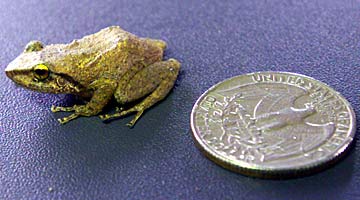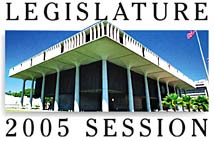
|
Bills seek to muffle
isle frog
Both bills seek funds to eradicate
the noisy non-native species
A sensitive ear might detect a slight tremble in the deafening racket created by little coqui frogs.
Two House committees advanced two bills last week that officials hope will help silence the noisy frogs that have flourished in Hawaii for a decade.
|
|
The frog -- which subsists on the same diet of insects as native birds -- could be the greatest threat to state's ecosystem that anyone has ever seen before, Kim said.
And while the sound of the frogs' "ko-KEE, ko-KEE" is welcome in their native Puerto Rico, the chirping of thousands of frogs can reach 70 decibels in what would otherwise be quiet Big Island neighborhoods, he said.
"I ask for and beg you for your help to see what we can do ... ," Kim said.
One of the bills before the Legislature asks for $4 million over the next two years to establish a frog eradication program on the Big Island -- which is particularly troubled by the quarter-sized frogs. Another bill asks for unspecified funds to be appropriated for a statewide program.
The state Department of Land and Natural Resources supports the idea behind the bills, Chairman Peter Young said.
But there is the concern that if all the money is funneled to specific issues, the state might lose sight of the big picture, he said.
Two years ago, the Legislature authorized the creation of the Hawaii Invasive Species Council, which last year was budgeted $4 million from the Natural Area Reserve fund.
Late last month, the department asked the Legislature for another $4 million to help fight invasive species.
Confronting invasive species issues through the council is the best way to deal with the problems, Young said.
"Too long invasive species have been out of sight and out of mind," Young said after the hearing.
Many people have come to accept invasive species as part of Hawaii's environment, he said.
In testimony submitted to the committees, Animal Rights Hawaii said the coqui frog should be accepted along with other introduced species such as the mongoose and peacock.
"They did not plan on the invasion," the statement said.
But non native species can have a devastating domino effect on the state's environment and economy, Young said.
The miconia plant grows to tower over and shadow out native undergrowth, which dies, leaving the soil unprotected. That unprotected soil can then be carried away by runoff that flows into the ocean and ruins coral reefs, he said.
There is a social impact, too.
Unable to sleep at night, people in coqui frog-infested areas call into Kim's office complaining about the nightly noise, Young said.
"You get 10,000 of those little things, it is unbelievable," he said.
[News] [Business] [Features] [Sports] [Editorial] [Do It Electric!]
[Classified Ads] [Search] [Subscribe] [Info] [Letter to Editor]
[Feedback]

